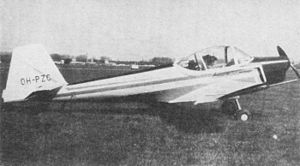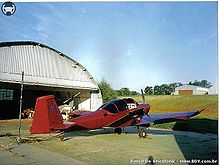- PZL-102 Kos
-
PZL-102 Kos Role Two-seat touring/training monoplane Manufacturer PZL First flight 23 May 1958 Introduction 1959 Produced 1959-1962 Number built 10 The PZL-102 Kos is a Polish two-seat touring and training monoplane designed and built by PZL.
Contents
Development
First flown on 21 May 1958 by Mieczysław Miłosz the PZL-102 was designed as a semi-aerobatic two-seat light monoplane and was later given the name Kos (Blackbird). The Kos was an all-metal low-wing cantilever monoplane with fabric tail control surfaces. It had a fixed tailwheel landing gear and the prototype had a nose-mounted 65hp (48kW) Narkiewicz WN-1 flat-four engine. The Kos had an enclosed cockpit for two side-by-side. After a number of prototypes the production aircraft (designated PZL-102B) first flew in October 1959, with Continental C90 engine and changed wing construction. Only short series was produced, because it needed imported engine.
Operational history
Between 13 May and 8 June 1960 Antoni Szymański made 9000 km commercial flight on PZL-102B on route Warsaw - Vienna - Geneva - Reims - London - Luxembourg - Berlin - Warsaw.
Seven aircraft were sold abroad. Austrian aircraft were operated for agrospraying purposes. Tank filled with chemical agent was placed on the passenger seat.
One PZL-102 has been restored to airworthy condition (markings SP-EFA).
Variants
- PZL-102A
- Prototypes
- PZL-102B
- Production variant with Continental C90 engine.
There is another PZL 102B restored in South Africa, based at Jack Taylor Airfield Krugersdorp, and one more in Brazil (PT-BGP)
Operators
Specifications (PZL-102B)
Data from The Illustrated Encyclopedia of Aircraft (Part Work 1982-1985). Orbis Publishing. pp. 2675.
General characteristics
- Crew: 1 pilot
- Capacity: 1 passenger
- Length: 6.95 m (22 ft 9½ in)
- Wingspan: 8.50 m (27 ft 10½ in)
- Height: 1.90 m (6 ft 2¾ in)
- Wing area: 11 m2 (118.41 ft2)
- Empty weight: 418 kg (992 lb)
- Gross weight: 655 kg (1444 lb)
- Powerplant: 1 × Continental C90-12F flat-four piston engine, 71 kW (95 hp)
Performance
- Maximum speed: 190 km/h (118 mph)
- Range: 640 km (398 miles)
- Service ceiling: 4600 m (15,090 ft)
References
- Taylor, Michael J. H. (1989). Jane's Encyclopedia of Aviation. London: Studio Editions.
- The Illustrated Encyclopedia of Aircraft (Part Work 1982-1985). Orbis Publishing. pp. 2675.
External links
PZL aircraft PZL - up to 1939
(Państwowe Zakłady Lotnicze)PZL: P.1 · Ł.2 · PZL.3 · PZL.4 · PZL.5 · P.6 · P.7 · P.8 · P.11 · PZL.12 (PZL-H) · PZL.16 · PZL.19 · PZL.23 Karaś · P.24 · PZL.26 · PZL.27 · PZL.30 Żubr · PZL.37 Łoś · PZL.38 Wilk · PZL.39 · PZL.42 · PZL.43 · PZL.44 Wicher · PZL.45 Sokół · PZL.46 Sum · PZL.48 Lampart · PZL.49 Miś · PZL.50 Jastrząb · PZL.53 Jastrząb II · PZL.54 Ryś · PZL.55 · PZL.56 Kania ·
CSS / WSK-Okęcie
/ PZL Warszawa-OkęciePZL: PZL-101 Gawron · PZL-102 Kos · PZL-104 Wilga · PZL-105 Flaming · PZL-106 Kruk · PZL-110 Koliber · PZL-111 Koliber · PZL-112 Junior · PZL-126 Mrówka · PZL-130 Orlik · PZL-230 Skorpion
Other produced: WSK Junak · CSS-10 · CSS-11 · CSS-12 · CSS-13 · PZL Jak-12 · MD-12
WSK-Mielec / WSK PZL-Mielec
/ PZL Mielec (Polskie Zakłady Lotnicze)WSK-Świdnik / WSK PZL-Świdnik / PZL-Świdnik WSK PZL-Krosno KR-03
Szybowcowy Zakład Doświadczalny
/ PZL Bielsko-Biała / Allstar PZL GliderSZD-6 · SZD-7 · SZD-8 · SZD-9 · SZD-10 · SZD-11 · SZD-12 · SZD-13 · SZD-14 · SZD-15 · SZD-16 · SZD-17 · SZD-18 · SZD-20 · SZD-21 · SZD-22 · SZD-23 · SZD-24 · SZD-25 · SZD-26 · SZD-27 · SZD-28 · SZD-29 · SZD-30 · SZD-31 · SZD-32 · SZD-33 · SZD-34 · SZD-35 · SZD-36 · SZD-37 · SZD-38 · SZD-39 · SZD-40 · SZD-41 · SZD-42 · SZD-43 · SZD-45 · SZD-48 · SZD-49 · SZD-50 · SZD-51 · SZD-52 · SZD-54 · SZD-55 · SZD-56 · SZD-59
Lists relating to aviation General Aircraft (manufacturers) · Aircraft engines (manufacturers) · Airlines (defunct) · Airports · Civil authorities · Museums · Registration prefixes · Rotorcraft (manufacturers) · TimelineMilitary Accidents/incidents Records Categories:- Polish civil utility aircraft 1950–1959
Wikimedia Foundation. 2010.


